Punjab State Board PSEB 10th Class Maths Book Solutions Chapter 6 Triangles Ex 6.2 Textbook Exercise Questions and Answers.
PSEB Solutions for Class 10 Maths Chapter 6 Triangles Ex 6.2
Question 1.
In fig. (i) and (ü), DE U BC. Find EC in (i) and AD in (ii).
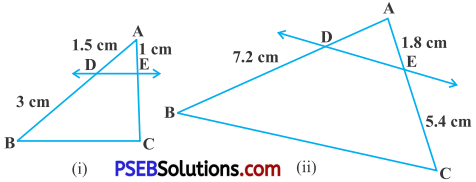
Solution:
(i) In ∆ABC, DE || BC ……………(given)
∴ \(\frac{\mathrm{AD}}{\mathrm{BD}}=\frac{\mathrm{AE}}{\mathrm{EC}}\)
[By using Basic Proportionality Theorem]
\(\frac{1.5}{3}=\frac{1}{\mathrm{EC}}\)
EC = \(\frac{3}{1.5}\)
EC = \(\frac{3 \times 10}{15}\) = 2
∴ EC = 2 cm.
(ii) In ∆ABC,
DE || BC ……………(given)
∴ \(\frac{\mathrm{AD}}{\mathrm{BD}}=\frac{\mathrm{AE}}{\mathrm{EC}}\)
[By using Basic Proportionality Theorem]
\(\frac{\mathrm{AD}}{7.2}=\frac{1.8}{5.4}\)
AD = \(\frac{1.8 \times 7.2}{5.4}\)
= \(\frac{1.8}{10} \times \frac{72}{10} \times \frac{10}{54}=\frac{24}{10}\)
AD = 2.4
∴ AD = 2.4 cm.
![]()
Question 2.
E and F are points on the sides PQ and PR respectively of a APQR. For each of the following cases, state whether EF || QR :
(i) PE = 3.9 cm, EQ = 3 cm, PF = 3.6 cm and FR = 2.4 cm
(ii) PE =4 cm, QE = 4.5 cm, PF =8 cm and RF = 9cm.
(iii) PQ = 1.28 cm, PR = 2.56 cm, PE = 0.18 cm and PF = 0.36 cm.
Solution:
In ∆PQR, E and F are two points on side PQ and PR respectively.
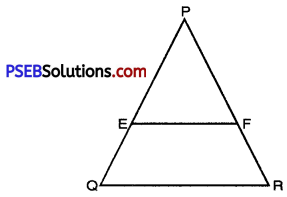
(i) PE = 3.9 cm, EQ = 3 cm
PF = 3.6 cm, FR = 2.4 cm
\(\frac{\mathrm{PE}}{\mathrm{EQ}}=\frac{3.9}{3}=\frac{39}{30}=\frac{13}{10}=1.3\)
∴ EF is not parallel to QR.
(ii) PE = 4 cm, QE = 4.5 cm,
PF = 8 cm, RF = 9 cm.
\(\frac{\mathrm{PE}}{\mathrm{QE}}=\frac{4}{4.5}=\frac{40}{45}=\frac{8}{9}\) ………….(1)
\(\frac{P F}{R F}=\frac{8}{9}\) ……………..(2)
From (1) and (2),
\(\frac{\mathrm{PE}}{\mathrm{QE}}=\frac{\mathrm{PF}}{\mathrm{RF}}\)
∴ By converse of Basic Proportionality theorem EF || QR.
(iii) PQ = 1.28 cm, PR = 2.56 cm
PE = 0.18 cm, PF = 0.36 cm.
EQ = PQ – PE = 1.28 – 0.18 = 1.10 cm
ER = PR – PF = 2.56 – 0.36 = 2.20 cm
Here \(\frac{\mathrm{PE}}{\mathrm{EQ}}=\frac{0.18}{1.10}=\frac{18}{110}=\frac{9}{55}\) …………..(1)
and \(\frac{\mathrm{PF}}{\mathrm{FR}}=\frac{0.36}{2.20}=\frac{36}{220}=\frac{9}{55}\) …………….(2)
From (1) and (2), \(\frac{\mathrm{PE}}{\mathrm{EQ}}=\frac{\mathrm{PF}}{\mathrm{FR}}\)
∴ By converse of Basic Proportionality Theorem EF || QR.
![]()
Question 3.
In fig., LM || CB; and LN || CD. Prove that \(\frac{\mathbf{A M}}{\mathbf{A B}}=\frac{\mathbf{A N}}{\mathbf{A D}}\).
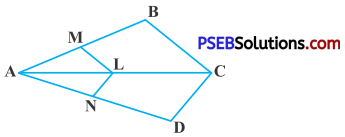
Solution:
In ∆ABC,
LM || BC (given)
∴ \(\frac{\mathrm{AM}}{\mathrm{MB}}=\frac{\mathrm{AL}}{\mathrm{LC}}\) ………..(1)
(By Basic Proportionality Theorem)
Again, in ∆ACD
LN || CD (given)
∴ \(\frac{A N}{N D}=\frac{A L}{L C}\) …………..(2)
(By Basic Proportionality Theorem)
From (1) and (2),
\(\frac{\mathrm{AM}}{\mathrm{MB}}=\frac{\mathrm{AN}}{\mathrm{ND}}\)
or \(\frac{\mathrm{MB}}{\mathrm{AM}}=\frac{\mathrm{ND}}{\mathrm{AN}}\)
or \(\frac{\mathrm{MB}}{\mathrm{AM}}+1=\frac{\mathrm{ND}}{\mathrm{AN}}+1\)
or \(\frac{\mathrm{MB}+\mathrm{AM}}{\mathrm{AM}}=\frac{\mathrm{ND}+\mathrm{AN}}{\mathrm{AN}}\)
or \(\frac{\mathrm{AB}}{\mathrm{AM}}=\frac{\mathrm{AD}}{\mathrm{AN}}\)
or \(\frac{\mathrm{AM}}{\mathrm{AB}}=\frac{\mathrm{AN}}{\mathrm{AD}}\)
Hence, \(\frac{\mathrm{AM}}{\mathrm{AB}}=\frac{\mathrm{AN}}{\mathrm{AD}}\) is the required result.
![]()
Question 4.
In Fig. 6.19, DE || AC and DF || AE. Prove that \(\frac{\mathrm{BF}}{\mathrm{FE}}=\frac{\mathrm{BE}}{\mathrm{EC}}\).
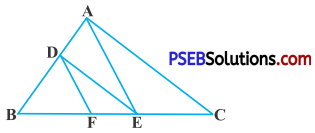
Solution:
In ∆ABC, DE || AC(given)

∴ \(\frac{B D}{D A}=\frac{B E}{E C}\) …………….(1)
[By Basic Proportionality Theorem]
In ∆ABE, DF || AE
\(\frac{\mathrm{BD}}{\mathrm{DA}}=\frac{\mathrm{BF}}{\mathrm{FE}}\) …………….(2)
[By Basic Proportionality Theorem]
From (1) and (2),
\(\frac{\mathrm{BE}}{\mathrm{EC}}=\frac{\mathrm{BF}}{\mathrm{FE}}\)
Hence proved.
![]()
Question 5.
In fig. DE || OQ and DF || OR. Show that EF || QR.
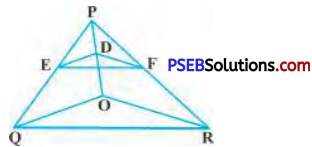
Solution:
Given:
In ∆PQR, DE || OQ DF || OR.
To prove: EF || QR.
Proof: In ∆PQO, ED || QO (given)
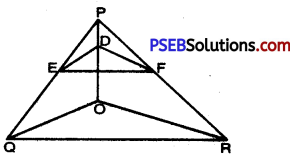
∴ \(\frac{P D}{D O}=\frac{P E}{E Q}\)
[By Basic Proportionality Theorem]
Again in ∆POR,
DF || OR (given)
∴ \(\frac{P D}{D O}=\frac{P F}{F R}\) ………….(2)
[By Basic Proportionality Theorem]
From (1) and (2),
\(\frac{\mathrm{PE}}{\mathrm{EQ}}=\frac{\mathrm{PF}}{\mathrm{FR}}\)
In ∆PQR, by using converse of Basic proportionaIity Theorem.
EF || QR,
Hence proved.
![]()
Question 6.
In flg., A, B and C points on OP, OQ and OR respectively such that AB || PQ and AC || PR. Show thatBC || QR.
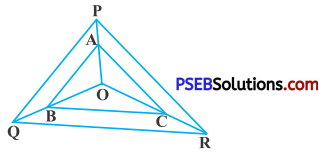
Solution:
Given : ∆PQR, A, B and C are points on OP, OQ and OR respectively such that AB || PQ, AC || PR.
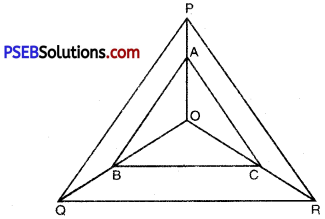
To prove: BC || QR.
Proof: In ∆OPQ, AB || PQ (given)
∴ \(\frac{\mathrm{OA}}{\mathrm{AP}}=\frac{\mathrm{OB}}{\mathrm{BQ}}\) …………….(1)
[BY using Basic Proportionality Theorem]
Again in ∆OPR.
AC || PR (given)
∴ \(\frac{\mathrm{OA}}{\mathrm{AP}}=\frac{\mathrm{OC}}{\mathrm{CR}}\) ……………….(2)
[BY using Basic Proportionality Theorem]
From (1) and (2),
\(\frac{\mathrm{OB}}{\mathrm{BQ}}=\frac{\mathrm{OC}}{\mathrm{CR}}\)
∴ By converse of Basic Proportionality Theorem.
In ∆OQR, BC || QR. Hence proved.
![]()
Question 7.
Using Basic Proportionality theorem, prove that a line drawn through the mid-point of one side of a triangle parallel to another side bisects the third side. (Recall that you have proved ¡t in class IX).
Solution:
Given: In ∆ABC, D is mid point of AB, i.e. AD = DB.
A line parallel to BC intersects AC at E as shown in figure. i.e., DE || BC.
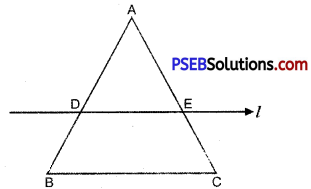
To prove: E is mid point of AC.
Proof: D is mid point of AB.
i.e.. AD = DB (given)
Or \(\frac{\mathrm{AD}}{\mathrm{BD}}\) = 1 ……………..(1)
Again in ∆ABC DE || BC (given)
∴ \(\frac{\mathrm{AD}}{\mathrm{DB}}=\frac{\mathrm{AE}}{\mathrm{EC}}\)
[By Basic Proportionality Theorem]
∴ 1 = \(\frac{\mathrm{AE}}{\mathrm{EC}}\) [From (1)]
∴ AE = EC
∴ E is mid point of AC. Hence proved.
![]()
Question 8.
Using converse of Basic Proportionality theorem prove that the line joining the mid-points of any two sides of a triangle is parallel to the third side. (Recall that you have done ¡tin Class IX).
Solution:
Given ∆ABC, D and E are mid points of AB and AC respectively such that AD = BD and AE = EC, D and Eare joined
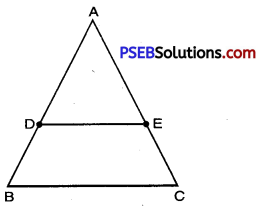
To Prove, DE || BC
Proof. D is mid point of AB (Given)
i.e., AD = BD
Or \(\frac{\mathrm{AD}}{\mathrm{BD}}\) = 1 ………………(1)
E is mid point of AC (Given)
∴ AE = EC
Or \(\frac{\mathrm{AE}}{\mathrm{EC}}\) = 1 ………………(2)
From (1) and (2),
By using converse of basic proportionality Theorem
DE || BC Hence Proved.
Question 9.
ABCD is a trapeiiumin with AB || DC and its diagonals Intersect each other at the point O. Show that \(\frac{A O}{B O}=\frac{C O}{D O}\).
Solution:
Given. ABCD is trapezium AB || DC, diagonals AC and BD intersect each other at O.
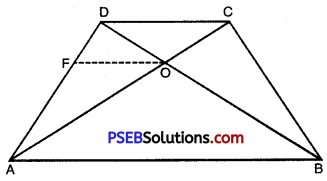
To Prove. \(\frac{\mathrm{AO}}{\mathrm{BO}}=\frac{\mathrm{CO}}{\mathrm{DO}}\)
Construction. Through O draw FO || DC || AB
Proof. In ∆DAB, FO || AB (construction)
∴ \(\frac{\mathrm{DF}}{\mathrm{FA}}=\frac{\mathrm{DO}}{\mathrm{BO}}\) ……………..(1)
[By using Basic Proportionality Theorem]
Again in ∆DCA,
FO || DC (construction)
\(\frac{\mathrm{DF}}{\mathrm{FA}}=\frac{\mathrm{CO}}{\mathrm{AO}}\)
[By using Basic Proportionality Theorem]
From (1) and (2),
\(\frac{\mathrm{DO}}{\mathrm{BO}}=\frac{\mathrm{CO}}{\mathrm{AO}} \quad \frac{\mathrm{AO}}{\mathrm{BO}} \quad \frac{\mathrm{CO}}{\mathrm{DO}}\)
Hence Proved.
Question 10.
The diagonals of a quadrilateral ABCD Intersect each other at the point O such that \(\frac{\mathrm{AO}}{\mathrm{BO}}=\frac{\mathrm{CO}}{\mathrm{DO}}\).Show that ABCD is a
trapezium.
Solution:
Given: Quadrilateral ABCD, Diagonal AC and BD intersects each other at O
such that = \(\frac{\mathrm{AO}}{\mathrm{BO}}=\frac{\mathrm{CO}}{\mathrm{DO}}\)
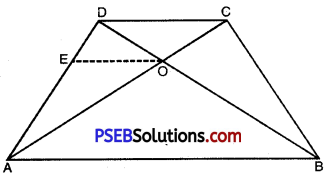
To Prove. Quadrilateral ABCD is trapezium.
Construction. Through ‘O’ draw line EO || AB which meets AD at E.
Proof. In ∆DAB,
EO || AB [Const.]
∴ \(\frac{\mathrm{DE}}{\mathrm{EA}}=\frac{\mathrm{DO}}{\mathrm{OB}}\) ………………(1)
[By using Basic Proportionality Theoremj
But = \(\frac{\mathrm{AO}}{\mathrm{BO}}=\frac{\mathrm{CO}}{\mathrm{DO}}\) (Given)
or \(\frac{\mathrm{AO}}{\mathrm{CO}}=\frac{\mathrm{BO}}{\mathrm{DO}}\)
or \(\frac{\mathrm{CO}}{\mathrm{AO}}=\frac{\mathrm{DO}}{\mathrm{BO}}\)
⇒ \(\frac{\mathrm{DO}}{\mathrm{OB}}=\frac{\mathrm{CO}}{\mathrm{AO}}\) …………….(2)
From (1) and (2),
\(\frac{\mathrm{DE}}{\mathrm{EA}}=\frac{\mathrm{CO}}{\mathrm{AO}}\)
∴ By using converse of basic
proportionlity Theorem,
EO || DC also EO || AB [Const]
⇒ AB || DC
∴ Quadrilateral ABCD is a trapezium with AB || CD.